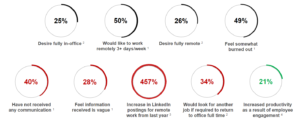Lately, I hear and read multiple news reports online and in my newsfeed about the challenges and decisions leaders and employees face about the pending “return-to-office.” What is your situation, and what is your level of readiness?
- Is your organization prepared for people to return to the office?
- Do you receive consistent messages from your leadership?
- Have you received clear policies and guidelines about the transition and if/when you and your team will go back onsite?
- Are leaders engaging their people to understand their desires and concerns about returning to the office?
If you are not able to respond to these questions with a confident “Yes!” you are not alone. Research confirms that many leaders are unsure about how and when to bring people back to the office. Also, many employees have concerns about their return to the office and expect to work differently in the post-pandemic world.

Sources: 1. McKinsey, 2021, 2. Robert Half, 2021, 3. LinkedIn, 2021, 4. Gallup, 2012
These startling statistics underscore the need for leaders to develop and deliver a clear and well-planned return-to-office strategy.
Based on our expertise guiding leaders through significant organizational change, we identified the following top six outcomes of a successful return-to-work engagement:
- Senior leaders and key stakeholders are aligned on strategy and engaged in the process. A successful return-to-office engagement starts with executives across the organizations who represent functional areas such as HR, IT, Facilities, and Legal. These leaders come together to determine who will lead the effort, which stakeholders need to be involved in decision-making, what policies and guidelines need to be in place, and the degree of employee feedback desired to shape decisions.
- Executives are prepared to make crucial decisions about relevant policies and guidelines. Executives explore and implement policies and guidelines in four key areas:
- Onsite or Hybrid Return-to-Office Strategy: Phasing and timing of the transition, treatment of vendors and visitors, and criteria for success
- Physical Occupation of Space: Use and etiquette of shared space, investment in alternative workspaces and equipment, and vaccination requirements
- Transition Back to the Office: Roles that require onsite work, how to prioritize groups to return onsite and/or organize hybrid work schedules
- Engagement and Visibility: Ensure messages are clear and consistent, success criteria are measured, and employee sentiment is tracked
- Managers have clear guidance for implementing policies. After executives have consulted with their leadership teams and developed relevant policies and guidelines, executives communicate with managers about parameters to implement return-to-office policies.
- Managers are prepared to lead their teams; grounded in consistency but tailored to their needs. With clear guidance on policies from executives, managers apply the policies and guidelines while adjusting to local requirements that may include leading in a hybrid environment.
- Employees are engaged and, therefore, more optimistic about the return-to-office strategy. Research finds that business units in the top quartile of productivity attribute 21% of that productivity to employee engagement Gallup). Thus, as managers solicit employee input about their needs and communicate decisions on the return-to-office strategy, employees will be more engaged in the process and supportive of the outcomes because leaders listened and considered their needs.
- Employee anxiety, fear, and resistance are reduced. As highlighted in the recent research studies earlier, the vast majority of employees do not want to return to the office full time (and will look for other jobs if required), many are burned out, and most have not received clear communications about what to expect. These statistics suggest that employees feel anxious, afraid, and will resist a return to the office. Thus, leaders must understand and address employees’ needs and concerns when developing policies and guidelines. The degree to which employees are engaged in decision making (e.g., developing the etiquette for shared spaces) will help also help reduce anxiety and turnover that can disrupt productivity.
The cumulative effect of these six outcomes will be a successful transition back to the office, whether fully onsite or a hybrid model, with an engaged and productive workforce.
To help our clients achieve these outcomes, we meet with key leaders across the organization to assess their current return-to-office policies and their readiness for the change. To increase employee engagement and gain insights into employee concerns and readiness, we survey employees to help leaders better formulate their onsite/hybrid strategy. Next, we facilitate workshops to identify and close gaps in return-to-office policies and guidelines. Finally, with participation from leaders and employees, we develop, implement, and help deliver plans that reduce fear and resistance, retain trust and confidence in leaders, and maintain employee productivity and customer service.
If you would like to discuss how we can assist your organization’s transition back to the office, please reach out to your Perficient contact or email me at Mike.Willis@perficient.com.
